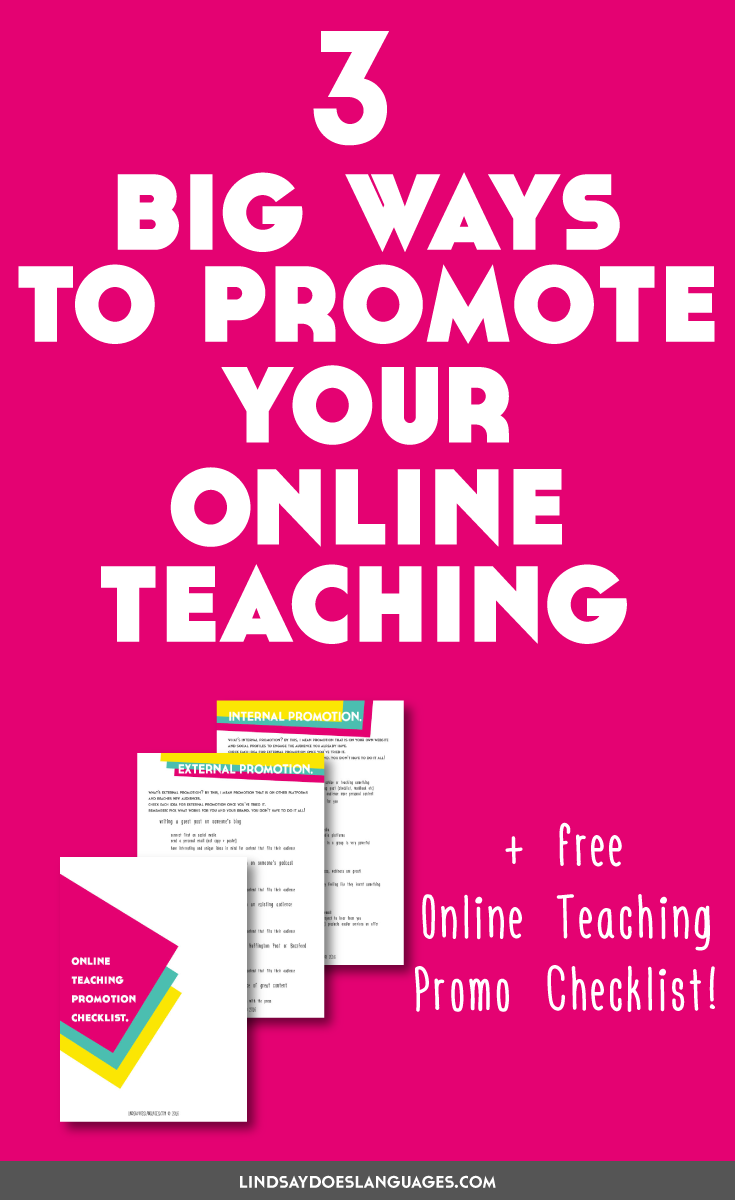September 14th, 2016
3 Big Ways to Promote Your Online Language Teaching Business
So you’re all set to teach online. You’ve got your resoruces lined up nicely in Google Drive, you’ve got your website finally looking how you want, and you’ve maybe even got a couple of your first students.
But where are the rest of them? Your online teaching business is not Field of Dreams. If you build it, they will not come. You want more students? Time to promote your online teaching.

Guest posts
When you’re just starting out, one big mistake people often make is to write plenty of content for their own blog, post all of them at once and then abandon the idea of blogging altogether. There are a few things wrong with this.
Number 1: you’ve probably worked really hard on creating these blogs and by posting all your content in one go, you’re not giving each one the space it deserves to be promoted, read, and shared.
Number 2: never mind space, how will people find your blog?! I highly recommend writing at least 5-10 posts in advance so you get ahead of your blogging schedule before you begin, but I also recommend not posting all of that content in one go and leaving it there. That’s where guest posting comes in.
Writing a post on someone else’s blog is a great way to reach a wider audience that may not know you yet but have similar interests because they’re reading similar blogs.
The key point there is similar. Don’t make the mistake of thinking “Argh! I need to be on the internet! There’s no-one in my niche with a big enough audience! I’m going to write guest posts on this massive blog and that huge website too!”
It’s better to have your guest post read by a small yet targeted audience than a large but mostly uninterested group of readers.
So how do you go about guest posting?
Don’t just shout out randomly and email cold – make connections first on Twitter or other social media platforms so that people have a chance to be familiar with you.
Make your emails personal – don’t rabbit on but share something you love about the person’s blog.
Make your post unique and interesting – to encourage people to actually care about you and click through to your site, your content needs to be useful and/or uniquely interesting.
Tell a story – have you overcome something? how you did something that people want to do? Share it.
If allowed, offer a bonus download – in exchange for an email address, give people something extra to compliment your blog post. This will give people the chance to engage with you in the future. Remember your content will have to be good enough to have people want to do this by the end of your post.
Related: Every Tool I Use to Make My Online Language Business Happen
Podcasts
Podcasts are a format that’s really popular right now. If you struggle writing blog posts or shy away from video content, consider starting a podcast instead.
But even if you don’t want to/can’t start your own right now, appearing on another podcast as a guest is a great way to get yourself found in podcast feeds when people search your name without actually having to go to the effort to create a podcast. And of course, just like writing guest posts, it gets you in front of a whole new audience.
Sometimes podcasts accept interviews, sometimes they feature guest hosts. The key thing here is to listen to the podcast you want to feature on so you know what their style is before sending out a blanket copied and pasted email to all. The advice above also stands for contacting podcast hosts.
So how do you go about starting a podcast?
You’ll need an idea – what will your podcast be about? Decide exactly who your podcast is for and jot down a few ideas for episodes.
Consider repurposing – will it be unique content or will you also transcribe content to make a blog post or film it for a video?
Find a place to host it – you don’t upload your podcast directly to iTunes. Instead, you’ll need a podcast host to act as the middleman. If your website is on Squarespace, you’re set as you can use that to host your podcast but if you use WordPress, you’ve got plenty of options to consider including Blubrry and Libsyn.
Read and learn before jumping in – Here’s a great tutorial from Pat Flynn that goes into great detail about each step you’ll need to think about when starting your podcast.
Related: The Ultimate Guide to Language Learning Podcasts
Webinars
Webinars, classes, workshops, call them what you will, live online sessions are a great way to give people a chance to engage with you on a live platform and also a chance for you to teach valuable things to them for free. Webinars are also a great method to actively share your offerings with your audience. So it’s a win win! Woohoo!
Why does live matter? Live is much more engaging than content, such as reading a blog post, that can be saved for later aka put off.
As well as giving value with the live session, you can also use the recording in the future as bonus course material or free downloadable content so other people can benefit from it AND you make the most of your time and effort creating and hosting the webinar. Again, win win.
So how do you go about hosting a webinar?
Useful, relevant, interesting – whatever you chose to share in your webinar, it has to be relevant to your audience. They have to care about what you have on offer because it’s either useful or interesting to them…or both if you’re really nailing it. 😉
Sign people up – share a link for your audience to sign up for your webinar so that you’re only emailing people before and after if they’re actually interested. Webinars can also be a great way to grow your email list!
Have something to offer them – whether it’s a Webinar Workbook, a product you’re sharing with them in the webinar, or a bonus freebie for signing up and attending, give your webinar attendees extra value so they feel loved. 🙂
But don’t be too pushy – if you’re using webinars as a way to promote your online teaching, great! Just make sure you save your selling to the end. You don’t want to lose your audience because they feel they’re being sold to rather than educated.
So there you have it! 3 great ways you can promote your online language teaching.
If you’re getting started with your online language teaching business, I hope this helped you to see how you can attract new students.
Take it further
If you’re ready to take things further and grow your online language teaching business, you’ll love the Online Teaching Starter Kit, which launches twice a year.
If transferring your teaching online is confusing the heck out of you and you need some inspiration to keep your language lessons fresh, try 100 Creative Ideas for Online Language Teachers, an ebook with digital supporting resources and templates.
Finally, get yourself organised with The Online Language Teacher Planner, a planner designed specifically with online language teachers in mind. Click here to find out more.







